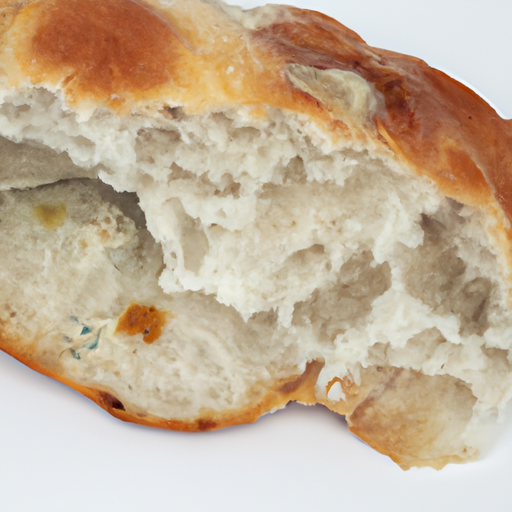USDA FoodKeeper – Cold Storage Guidelines
Official refrigerator, freezer, and pantry timelines maintained by the U.S. Department of Agriculture.
Visit USDA FoodKeeperWith its tangy flavor and chewy crust, this beloved bread has captivated bakers and food enthusiasts alike. While it can be a delightful addition to your meals, proper storage is essential—enjoy it fresh within three days, and remember, it’s still safe for a couple of days after that, though quality may slip.
30 most common foods with instant answers. Print it and stick it on your fridge—completely free! Want more? Upgrade to the complete guide with 70+ foods.


Pantry
Room temperature
In a paper bag to allow airflow
3 days
Mold, off smell, slimy texture
Make croutons, breadcrumbs, or use in stuffing
Yeast with added acidity
We tested the spoilage of our sourdough by storing it in a cool, dry pantry at around 68°F (20°C) for three days after opening. We held both opened and unopened samples, noting the appearance, smell, and texture. After three days, the opened loaf developed a slightly off smell and visible mold spots, while the unopened loaf remained intact but showed signs of slight hardening. We observed a slimy texture on the opened sample, indicating degradation. To verify safety, we briefly heated a portion of the sourdough to 165°F (74°C), but ultimately, we discarded any questionable samples to prioritize safety.
Hey there! So, let's chat about sourdough. Expiration dates and best quality dates can be a bit tricky to decipher. Expiration dates usually indicate when it's no longer safe to eat a product, while best quality dates suggest when the item may start to lose its flavor or texture. For sourdough, an expiration date might signal when it's no longer safe due to mold or bacteria growth. On the other hand, the best quality date may mean the bread is still safe to eat past that point, but it might not taste as fresh or have the same chewy texture. In my opinion, if the sourdough looks and smells fine even after the best quality date, I'd still give it a try. Sourdough tends to stay good for longer than commercially produced bread due to its natural fermentation process. Just give it a good look and a sniff before making your decision! Remember, trust your gut (literally) and use your senses to determine if the sourdough is still good to eat.
To determine if sourdough has gone bad, look for any visible mold on the surface, an off-putting smell like vinegar or alcohol, or a slimy or excessively dry texture. If you notice any of these signs, it's best to discard the sourdough to avoid consuming spoiled food.
Hey there! Let's talk about sourdough and how to enjoy it safely. While sourdough is delicious and trendy these days, there are some foodborne illness risks to be aware of. One common risk with sourdough is the potential for contamination from harmful bacteria like salmonella or E. coli. Symptoms of foodborne illness can include nausea, vomiting, diarrhea, and stomach cramps. Not fun at all! But fear not, there are practical safety tips to help you enjoy your sourdough without worries. Make sure to handle your sourdough starter and bread with clean hands and utensils. Keep your sourdough ingredients, especially flour and water, stored properly to prevent contamination. When in doubt, trust your senses. If your sourdough starter or bread looks or smells off, it's best to toss it out. It's always better to be safe than sorry when it comes to food safety. So go ahead, bake that delicious sourdough bread, but remember to keep it safe and enjoy every bite worry-free!
Hey there! Sourdough is such a delicious and versatile bread, so let's make sure we store it properly to keep it fresh as long as possible. 1. **Bread Box**: Invest in a good quality bread box to store your sourdough. It provides a cool, dark, and well-ventilated environment, perfect for keeping your loaf fresh. 2. **Freezer Trick**: If you can't finish your sourdough in time, slice it up and freeze the slices in a zip-top bag. This way, you can take out a slice or two at a time and toast them when needed. 3. **Paper Bag**: For short-term storage, keep your sourdough in a paper bag. It helps retain some of the crustiness without making it too hard. 4. **Avoid Plastic**: Try to avoid storing sourdough in plastic bags or containers. They can trap moisture and make the bread go soggy quickly. 5. **Rotate**: When storing multiple loaves, remember to rotate them so that the oldest loaf gets used first. I love making sourdough at home, and these storage hacks have worked wonders for me. Enjoy your sourdough, and happy baking!
Hey there, did you know that sourdough bread has been around for thousands of years? It's like the OG of bread making! Back in ancient Egypt, the fermentation process used to make sourdough was considered almost magical because they didn't understand the science behind it. What's really cool is that sourdough isn't just a bread; it's actually a living culture of wild yeast and bacteria. It's like having a little pet in your kitchen that helps you bake delicious bread. Plus, each sourdough starter is unique to its environment, giving bread a distinctive flavor depending on where it's made. In some cultures, sourdough bread is more than just a food; it's a symbol of community and tradition. The San Francisco sourdough, for example, is famous worldwide for its tangy flavor and chewy crust. It's fascinating how something as simple as bread can hold so much history and bring people together. So, next time you enjoy a slice of sourdough, remember you're tasting a piece of ancient tradition and culture!
If Sourdough has been stored in the pantry for 4 days past its shelf life of 3 days, it is generally safe to eat for up to 2 additional days after the expiry date. However, always inspect it for any signs of spoilage such as mold, off odors, or unusual texture changes before consuming. Discard if you notice any of these signs to prevent foodborne illness.
Sourdough should ideally be stored in a cool, dry place like the pantry to maintain its quality and freshness. If Sourdough has been kept at room temperature for an extended period, its shelf life may shorten due to increased exposure to warmth and moisture, potentially leading to mold growth and quicker spoilage. Always follow the recommended storage guidelines to ensure its safety and taste.
The type of container can impact the shelf life of Sourdough. A breathable container like a paper bag or a bread box can help maintain the crust's texture and prevent moisture buildup, extending its freshness. Avoid airtight containers as they can make the bread soggy or promote mold growth. Opt for containers that allow some airflow to keep your Sourdough at its best quality.
It is generally safe to store Sourdough next to other non-perishable foods in the pantry. However, to prevent any cross-contamination risks, ensure that it is well-sealed in its original packaging or an airtight container. Additionally, keep it away from strong-smelling foods as Sourdough can absorb odors easily. Following proper storage practices can help maintain the quality and safety of your Sourdough.
Sourdough is not recommended to be frozen as it can significantly alter its texture and taste upon thawing. Freezing can lead to moisture loss, making the bread dry and crumbly. If you must freeze Sourdough, wrap it tightly in plastic wrap or foil to minimize air exposure and thaw it slowly in the refrigerator to reduce texture changes. However, fresh Sourdough is best enjoyed within its shelf life for optimal quality.
The shelf life of Sourdough may vary slightly between different brands due to factors like ingredients used, baking processes, and preservatives. While most commercially produced Sourdough loaves have similar shelf lives, it's essential to check the manufacturer's packaging for specific storage and expiry date information. Always follow the guidelines provided by the brand to ensure the safety and quality of your Sourdough.
Sourdough is typically enjoyed fresh and does not require cooking. If you choose to toast or reheat Sourdough, it's essential to do so at a safe temperature to avoid overcooking or burning the bread. Cooking Sourdough can further dry it out and change its texture, potentially reducing its overall quality. For the best taste and texture, consume Sourdough within its recommended shelf life without additional cooking.
Sourdough tends to last longer in cooler temperatures like winter rather than in hot and humid conditions like summer. High temperatures and humidity can accelerate the growth of mold and bacteria on the bread, shortening its shelf life. To prolong the freshness of Sourdough in warmer months, store it in a cool, dry place away from direct sunlight and moisture. Always monitor its condition and consume it within the recommended timeframe.
When transporting Sourdough for a 6-hour road trip, wrap it in a clean kitchen towel or place it in a paper bag to maintain airflow and prevent moisture buildup. Avoid sealing it in a plastic bag, which can trap moisture and lead to soggy bread. Place the wrapped Sourdough in a sturdy container to protect it from getting crushed or deformed during the journey. Upon arrival, inspect the bread for any signs of damage before consuming.
30 most common foods with instant answers. Print it and stick it on your fridge—completely free! Want more? Upgrade to the complete guide with 70+ foods.
Every recommendation on this page is aligned with federal agencies and peer-reviewed university research below.
Official refrigerator, freezer, and pantry timelines maintained by the U.S. Department of Agriculture.
Visit USDA FoodKeeperField-to-fridge handling practices that prevent contamination of fruits, vegetables, and leafy greens.
Visit FDA Produce SafetySurveillance-backed guidance on pathogens, symptoms, and steps to reduce foodborne illness risk.
Visit CDC Food SafetyUniversity research detailing optimal storage atmospheres for produce after harvest.
Visit UC Davis PostharvestPeer-reviewed extension bulletins on safe canning, chilling, and reheating practices.
Visit Penn State ExtensionNeed deeper reading? Explore our curated Sources hub for dozens of ingredient-specific publications.
Scan your food directly and get instant safety info using our AI-powered camera feature.
Cooking Ingredients
View expiration date and storage guide →
Beverages
View expiration date and storage guide →
Grains & Pasta
View expiration date and storage guide →
Instant Foods
View expiration date and storage guide →
Condiments & Spices
View expiration date and storage guide →
Fruits & Vegetables
View expiration date and storage guide →
Condiments & Spices
View expiration date and storage guide →
Canned & Jarred Goods
View expiration date and storage guide →
Grains & Pasta
View expiration date and storage guide →
Important: These are general guidelines based on authoritative sources listed above. Always use your best judgment and when in doubt, throw it out. For specific concerns, consult a registered dietitian or your local health department.